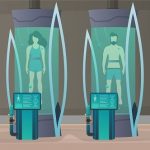 Technology
Technology  Technology
Technology  Humans
Humans 10 Everyday Human Behaviors That Are Actually Survival Instincts
 Animals
Animals 10 Animals That Humiliated and Harmed Historical Leaders
 History
History 10 Most Influential Protests in Modern History
 Creepy
Creepy 10 More Representations of Death from Myth, Legend, and Folktale
 Technology
Technology 10 Scientific Breakthroughs of 2025 That’ll Change Everything
 Our World
Our World 10 Ways Icelandic Culture Makes Other Countries Look Boring
 Misconceptions
Misconceptions 10 Common Misconceptions About the Victorian Era
 Mysteries
Mysteries 10 Strange Unexplained Mysteries of 2025
 Miscellaneous
Miscellaneous 10 of History’s Most Bell-Ringing Finishing Moves
 Technology
Technology Top 10 Everyday Tech Buzzwords That Hide a Darker Past
 Humans
Humans 10 Everyday Human Behaviors That Are Actually Survival Instincts
 Animals
Animals 10 Animals That Humiliated and Harmed Historical Leaders
Who's Behind Listverse?

Jamie Frater
Head Editor
Jamie founded Listverse due to an insatiable desire to share fascinating, obscure, and bizarre facts. He has been a guest speaker on numerous national radio and television stations and is a five time published author.
More About Us History
History 10 Most Influential Protests in Modern History
 Creepy
Creepy 10 More Representations of Death from Myth, Legend, and Folktale
 Technology
Technology 10 Scientific Breakthroughs of 2025 That’ll Change Everything
 Our World
Our World 10 Ways Icelandic Culture Makes Other Countries Look Boring
 Misconceptions
Misconceptions 10 Common Misconceptions About the Victorian Era
 Mysteries
Mysteries 10 Strange Unexplained Mysteries of 2025
 Miscellaneous
Miscellaneous 10 of History’s Most Bell-Ringing Finishing Moves
10 Controversial Experiments Conducted on Children
Through experiments, scientists and psychologists hope to improve the lives of humans and uncover new information that can benefit our health and well-being. Sometimes, these experiments can be looked at as unconventional and controversial when conducted on humans. Many believe these experiments cross ethical lines, especially when children are involved. Here are ten controversial experiments conducted on children.
Related: 10 Mind-Boggling Scientific Experiments Involving Pigs
10 Practice-Babies Program
Between 1926 and 1947, hundreds of babies were on loan from local orphanages to several big-name colleges as part of their home economics program. Students were given the opportunity to practice parenting on real newborns. These young “practice babies” would be cared for by a group of students in the program. The baby would have about eight students responsible for their feeding, napping, and every other need.
The baby’s identity would remain anonymous, but they would be given a name followed by the surname Domecon, which meant “domestic economy.” The baby would leave the group of students after a couple of years to find an adoptive family. These kids were orphans and received excellent nutrition, good healthcare, and lots of attention. Still, many believe the program negatively affected these children by not being able to create a tight bond with others.
Some kids used as practice babies claimed they had issues getting close to anyone as they grew up and felt they didn’t know how to love anyone. They also claimed to be hurt on the inside because they felt as if they were used. They did agree that they were probably given excellent care. Still, they blame the program for issues they developed as an adult.[1]
9 Racism Among Elementary Students
In 1968, shortly after the assassination of Martin Luther King Jr., elementary school teacher Jane Elliott conducted a groundbreaking and controversial classroom experiment to help her eight-year-old students understand the realities of racism. Frustrated by the difficulty of explaining systemic discrimination, Elliott devised a powerful, experiential lesson on prejudice. Her method involved dividing her all-white, small-town Iowa classroom into two groups based on a seemingly arbitrary characteristic: eye color.
On the first day, Elliott declared that students with blue eyes were superior, smarter, and more deserving of privileges, such as extra recess time and front-row seating. Meanwhile, children with brown eyes were labeled as inferior, denied certain rights, and subjected to ridicule. The impact was immediate. The blue-eyed students became more confident, assertive, and even condescending, while the brown-eyed students displayed visible signs of shame, frustration, and insecurity. A few days later, Elliott reversed the roles, allowing the students to experience both sides of discrimination.
The experiment was met with significant backlash, with some parents and community members criticizing Elliott for subjecting young children to such an emotionally charged exercise. However, many of her former students later reflected on the experience as life-changing, describing how it opened their eyes to the harm caused by prejudice and discrimination. Despite the controversy, Elliott’s experiment remains a powerful, if polarizing, example of how hands-on learning can profoundly impact attitudes about race and equality.[2]
8 Monster Study
In 1936, Dr. Wendell Johnson conducted a controversial experiment on children to learn more about why they stutter. Johnson chose 22 orphans to participate in the study; some children had a stutter while others did not. The children were split into two groups labeled “normal speakers” and “stutterers,” with stutterers and non-stutterers in each group. The children in the normal group were treated well and told they spoke well, but the children in the stutterers’ group were told to not speak unless they could do it correctly.
The children in the normal group did not see improvement in their speaking after being praised by the researchers, but some of the kids in the other group did not do as well. Five of the six children who were falsely scolded for their speech developed speech problems. Many believe that lines were crossed by using orphans, especially without their consent. Some of the students with a stutter would suffer from psychological trauma, their schoolwork suffered, and one even ran away from the orphanage two years later. The study was so horrifying that it would later be known as “The Monster Study.”[3]
7 Dr. Money Gender Experiment
David Reimer was born in 1965 along with his twin brother, but when he was only eight months old, his penis would accidentally be cut off during a botched circumcision. Reimer’s parents contacted Dr. John Money, a psychologist, to help deal with the situation. Money had a theory that a child would assume the gender identity that it was raised with rather than its biological sex. At 22 months old, Reimer underwent surgery to remove his genitals and to have female genitals constructed. His parents then changed his name to Brenda and raised him as a female.
Reimer was forced to play with typical female toys and dress as a female, but he would complain to his parents that he felt like a boy and didn’t want to wear dresses or play with dolls. He suffered from severe emotional and psychological issues as a teenager and eventually found out what happened. He then transitioned back to a male. The psychological trauma that he continued to endure into his adulthood finally drove him to commit suicide at the age of 38.[4]
6 Hepatitis in Mentally Disabled Children
The Willowbrook State School in New York, an institution for mentally disabled children, saw an outbreak of hepatitis in the 1950s. The children at the institution were exposed to unsanitary conditions, which led to the hepatitis outbreak. Dr. Saul Krugman proposed research that would help distinguish between strains of hepatitis to develop a vaccine, but the study would mean that local strains of hepatitis would be fed to children, infecting them on purpose.
He argued that the children would be exposed to the same strands under natural conditions, and there would be only minor harm to the children. Only children with consent from a parent would be included, but critics believed that the permission letter was deceiving. Admission to the school was nearly impossible due to crowding, but there was a promise of admission for those consenting.[5]
5 Electroshock Therapy
Dr. Lauretta Bender, a prominent psychiatrist in the mid-20th century, became infamous for her controversial use of electroshock therapy on children. During the 1960s, while working at New York’s Creedmoor Psychiatric Center, Bender sought to treat children with social and behavioral issues using experimental methods. She believed she could identify early signs of schizophrenia in children through unconventional techniques. In her sessions, she interviewed children in front of large groups, applying light pressure to their heads and interpreting their reactions. Any movement in response to this pressure, she theorized, was indicative of a predisposition to schizophrenia, though her methodology lacked scientific rigor.
Bender’s approach extended to administering electroshock therapy to over 100 children, a practice widely criticized for its ethical implications and questionable effectiveness. Her methods caused significant emotional and physical trauma to many young patients. Though some regarded her as a child psychiatry pioneer, her detractors saw her as unsympathetic and driven by unproven theories. Ultimately, her experiments were shut down, leaving a dark legacy in the history of psychiatric treatments. Today, Bender’s work serves as a cautionary tale, highlighting the critical importance of ethical standards and evidence-based practices in medical and psychological research.[6]
4 Little Albert
John B. Watson and Rosalie Rayner conducted a controversial study known as the Little Albert Experiment. Little Albert was the pseudonym of a young boy who was at the center of the famous experiment. The boy was exposed to a number of items, including a monkey, burning newspapers, and a white rat, to see his reaction to the items. Albert showed no fear of these items when the experiment began, but Watson made some adjustments that would change how the boy looked at the items.
When exposed to the white rat, Watson hit a metal pipe with a hammer to create a loud noise. The boy would cry after the loud noise, and Watson would repeat the experiment several times until the boy expected the noise and would cry after simply seeing the rat. The presence of the rat was distressing for Albert, and it soon led to other fears of anything else white or fluffy. They were trying to show how classical conditioning can be used to create an emotional response.[7]
3 Bobo Doll Experiment
Albert Bandura conducted an experiment in 1961 to investigate if social behaviors can be acquired by imitation. The control group was made up of 36 girls and 36 boys between the ages of three and six years old, and each child was pre-tested to determine an aggression level rated on a 5-point rating scale. Children were matched with others with similar levels of aggression and split into three groups.
The first group was shown a video of an adult punching and attacking a Bobo Doll, one of those crazy inflatable clown bop bags. The second group received a non-violent video, and the last group was not given a video. The three groups were then released in a room with a Bobo Doll. The first group instantly started attacking the inflatable clown, while the other two groups were much less aggressive. Critics argued that this experiment proved nothing because the Bobo Doll was designed to be hit and kicked.[8]
2 Visual Cliff Experiment
Babies are surprisingly smart enough to understand that they shouldn’t crawl close enough to the edge of something to fall off. Still, two psychologists wanted to study the phenomenon. They built a visual cliff made up of boards laid across a heavy sheet of glass. Patterned fabric was then added to a portion of the contraption to make it look like the transition from boards to bare glass was a drop-off.
The control group was made up of 36 infants, and their mothers would try to trick them into crawling across the bare glass. Most of the babies crawled away from their mothers to stay away from the fake edge, and only three crawled over the fake cliff. The researchers noticed that many babies crawled close enough to the glass that they would have fallen off a real cliff.[9]
1 Robbers Cave Experiment
One of the more cited social psychology experiments is the Robbers Cave Experiment. Muzafer Sherif conducted a study involving 22 boys in Oklahoma to learn more about intergroup conflict and cooperation. The boys separated into two groups at Robbers Cave State Park would learn to hate each other. The two groups were kept apart from each other for the first week, and they did not know that the other group existed. They were encouraged to participate in team-building events and form relationships.
When each group started to bond and become close, the two groups were introduced to each other. To produce conflict, the groups would have to participate in tournaments against each other, with prizes for the winners. The groups slowly started to hate each other as they started by yelling at each other, but it would later lead to fist fights and other aggression. After one group finally won the tournament, the other group of boys ransacked their cabin and stole from them.[10]








